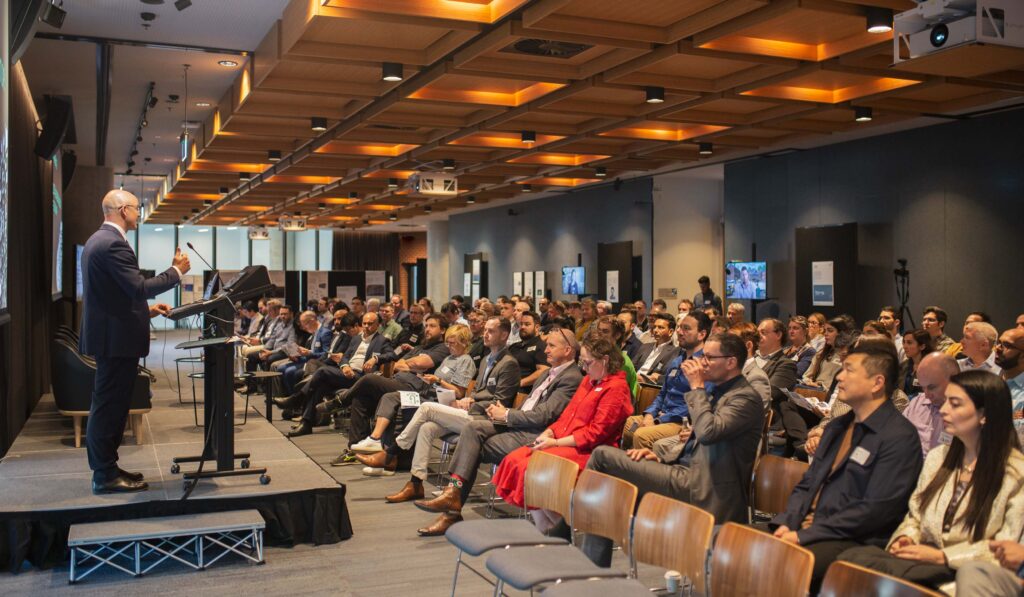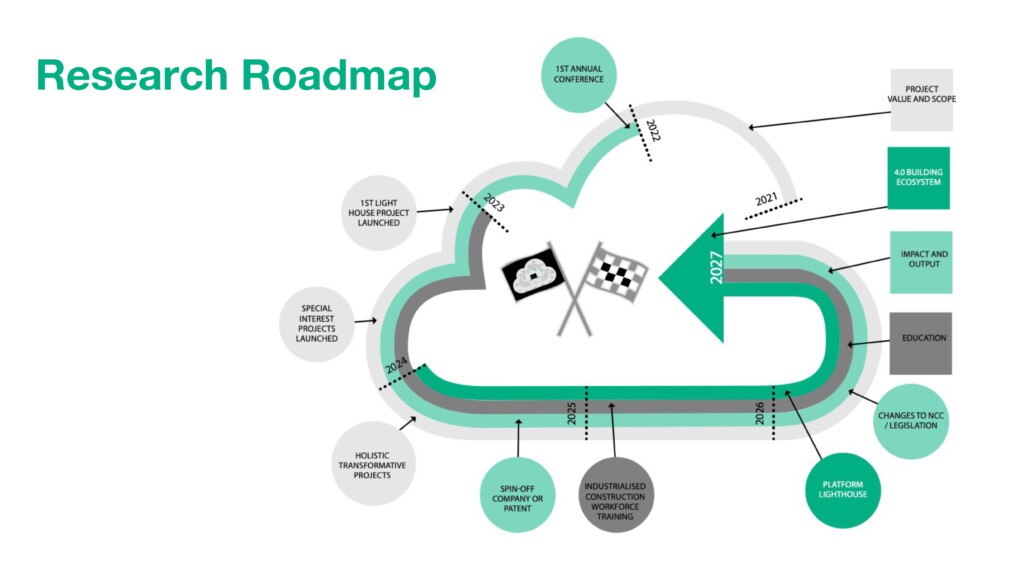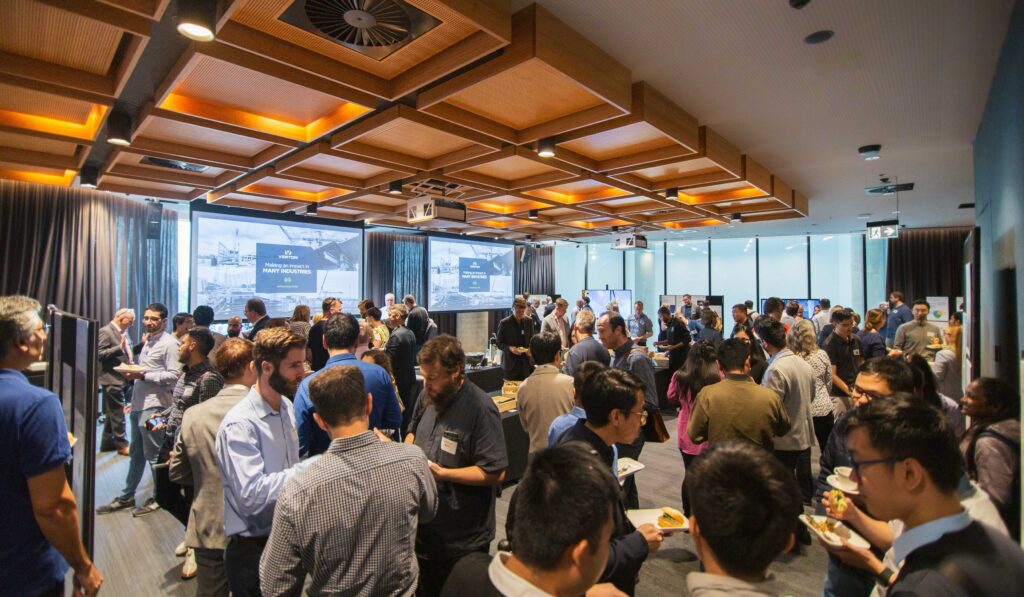Annual Showcase 2023 – Showcasing the impact on industry
Successfully transforming Australia’s building and construction industry requires new technologies and new practices. But these new technologies and practices are only part of the solution. Collaborating, co-creating, building relationships and engaging stakeholders is the other part of the solution.
That’s where the Building 4.0 CRC comes in. This $130 million industry-led research initiative brings together both these ingredients for success: creating good and innovative ideas and establishing the connections and relationships that convert those ideas into practice.
Our recent Annual Showcase was an opportunity to do just that. As the name suggest, the Showcase profiles projects that can transform Australia’s building and construction industries. This year’s theme – ‘Impact on Industry’ – challenged stakeholders to look at things differently. It was a mix of presentations, demonstrations and exhibitions that covered all aspects of building and construction:
- Ensuring industry has the capability and capacity
- Establishing an authorising environment
- Getting down to the nitty gritty and demonstrating how we can move beyond business as usual.

| 150 attendees, almost double the number at our 2022 Showcase 18 presentations and demonstrations from industry partners and researchers 49 projects exhibited 28 PhD posters exhibited |
Keep reading to discover how the Annual Showcase 2023 highlighted that Building 4.0 is creating, improving and accelerating ‘Impact on Industry’ in 4 main ways:
1. Ensuring industry has the capability and capacity
- Dr Ross Digby from the Holmesglen Institute (Building 4.0 CRC’s vocational education and training partner) identified 3 top issues: new learning technologies, prefabrication, and workplace health and safety.
- Marcio Casagranda from industry partner Verton demonstrated a remote controlled crane solution that improves safety (by removing workers from the drop zone) and increases productivity (by increasing uptime).
- Phil Alviano (Master Builders Association of Victoria) introduced the MBAV’s Leadership Simulation Centre. This state-of-the-art training facility challenges participants with tasks, interactions and scenarios similar to a real building site, allowing workers to learn safely.
- Dr Ali Rashidi (Monash University) discussed using augmented and virtual reality technologies for vocational education and training (Project #12). This study identified the most significant factors that providers should consider when selecting VR/AR technologies to use in VET programs.
- Dr Tu Le (University of Melbourne) explained a new workflow that can automate the residential home design process (Project #42), working with industry partners Bentley Homes and M-Modular. This software makes it possible for design and project management platforms to communicate with each other, automating the process of transferring changes in the design platform to the platform estimating the materials used in the project.
2. Establishing an authorising environment (i.e. the legislation, regulations, policies and institutional settings that empower or constrain actions)
- Levi Robinson (Standards Australia) outlined ways Standards Australia is working to standardise processes and products for those in the building and construction industry, and improve accessibility to those standards.
- Stuart Lyons (Office of Projects Victoria) discussed the Victorian Government’s role in setting an agenda for greater industrialisation and digitalisation of building and construction. For example, the OPV sets policy and minimum standards for digital assets. The Victorian Government is a partner on Project #38, which aims to facilitate greater uptake of digitally integrated building and offsite construction in Victoria.
- Project #1 streamlines the planning and approvals process by using ePlanning and eApprovals. This project was part of a submission to the Victorian Parliament’s Inquiry into the Protections within the Victorian Planning Framework.
3. Getting down to the nitty gritty and demonstrating how we can move beyond business as usual
- Professor Mel Dodd (Monash University) introduced prefabricated housing solutions for areas affected by bushfires and other natural disasters (Project #35). This ‘kit of parts’ can be extended over time, transforming short-term temporary accommodation after a disaster into a long-term housing solution.
- Dr Philip Christopher (University of Melbourne) introduced a new integrated wall system that delivers greater energy performance and lowers the supply chain risk (Project #45). Industry partners Bentley Homes and Ultimate Windows are testing this prefabricated wall system in a demonstration home in Melbourne, to better understand its performance and how cost, energy performance and quality influence buyers’ decisions.
- Dr Alireza Chniforush (University of Melbourne) introduced a new flooring product developed by industry partner Viridi Group that combines steel, concrete and timber (Project #59). The aim is to produce a new product that minimises material use, facilitates modular construction, reduces manufacturing and construction costs and improves quality and aesthetics.
4. Making building and construction more sustainable (a cross-cutting theme)
- In a video presentation, Davina Rooney (Green Building Council Australia) discussed the GBCA’s role in promoting sustainability with Australia’s building industry. For Project #36, Building 4.0 CRC researchers are working with GBCA to better understand gaps in the performance of Green Star certified buildings.
- Dr Victor Bunster (Monash University) outlined Project #11, which is creating a framework for assessing the environmental credentials of building technology platforms, working with industry partner the Donovan Group. On the one hand, streamlining the design process produces environmental benefits. But on the other hand, these platforms have high computational requirements, which also have environmental effects.
- Dr Steve Psaltis (Queensland University of Technology) explained our work with Hyne Timber, which aims to find ways of using more of the tree to benefit all participants in the supply chain – growers, millers, builders and end users (Project #46). We’re using data analytics to interrogate data created by sensors in large sawmills and uncover useful and understandable data.
Professor Chris Knapp (Building 4.0 CRC Research Director) also explained the evolution of our research activities via our research roadmap.
Three years into our 7-year term, we are moving from generating new knowledge, ideas and technologies, to applying them in works on ground, to understand how they can work in practice.

Our Lighthouse Projects are a key element of that change, pairing built or to be built projects with research teams and market leading industry partners. At the showcase, we highlighted 2 Light House Projects:
- Dr Rachel Couper (Monash University) introduced Lighthouse Project #3 NCHA Independent Living Lab. This project aims to develop an efficient, sustainable and robust prefabricated building that also contains design features for healthy ageing.
- George Konstandakos (Sumitomo Forestry) discussed Lighthouse Project #6 Malvern East Apartment Development, a pilot project in Melbourne that aims to quantify the benefits of offsite construction and recommend improvements. Often, the benefits of offsite construction are not realised because the design consultants, developers and builders do not effectively collaborate to deliver integrated solutions.
The final session of the day was an interactive exercise led by Daniel Rex (Building 4.0 CRC Partnerships Director), posing 6 questions:
- What does the Australian building industry most need to change?
- What is a new method, standard, technology or way of doing business that you wish could be universally adopted throughout the building industry?
- What are the top 3 challenges to growth that your company faces?
- What are the top 2 technological challenges your company faces?
- What is a key challenge in your supply chain, which with the right amount of capital and focus, could probably be solved by collaborative innovation?
- What new project or challenge would you most like the Building 4.0 CRC to help bring multiple industry companies together to work on?
We received 507 answers from 70 participants. At the top of everyone’s mind was the desire to produce high-quality, affordable buildings and sustainable buildings that meet users’ needs. Common challenges included:
- applying new technologies to building and construction
- changing the culture to be more accepting of new ideas, technologies and people
- finding better ways of gathering and making the most of data
- nurturing a skilled workforce and protecting that workforce
- managing waste and reducing environmental impact.
These are all issues the Building 4.0 CRC is working on.

As well as delivering the latest information, the day created informal settings for people to get to know one another better, discuss new innovations and ideas, and see how they could help each other achieve our collective vision of transforming building and construction.
As we reflect on the day, we think about one of Professor Mathew Aitchison’s (CEO, Building 4.0 CRC) opening comments:
“Our Showcase theme for this year was ‘Impact on Industry’. By the end of this year, we’ll have somewhere between 30 and 40 projects complete. As we get to that level of maturity, we need to start thinking more about the impact of the research. Not just doing the research, but asking what is that impact going to be, how can we improve that impact and how can we accelerate that impact?”
Watch videos from the day here.